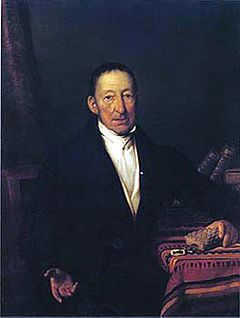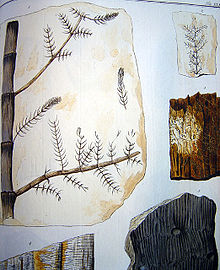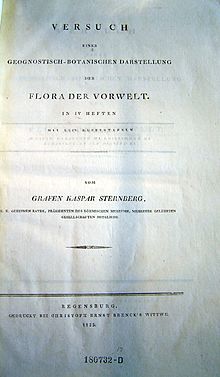Kaspar Maria von Sternberg
Kaspar Maria Graf Sternberg (also: Caspar , Czech: hrabě Kašpar Maria Šternberk ; born January 6, 1761 in Prague , † December 20, 1838 in Březina near Rokitzan) was a Habsburg- Bohemian theologian , politician , mineralogist and botanist . He is considered the founder of modern paleobotany . Its official botanical author's abbreviation is “ Sternb. "
Sternberg founded the Society of the Patriotic Museum in Bohemia , to which the Prague National Museum goes back. In 1785 Sternberg became cathedral chapter in Regensburg. In 1802 he was appointed as the deputy of Prince Karl Alexander von Thurn und Taxis to head the political administration in the Principality of Regensburg under Prince Primate Karl Theodor von Dalberg . From 1820 he was friends with Johann Wolfgang von Goethe .
Life
Childhood and youth
Kaspar Sternberg was born as the youngest of three sons of Count Johann von Sternberg and Countess Anna Josefa, b. Kolowrat Krakowský was born. Already at the age of eleven he was destined for a spiritual career and began his priestly training in the Collegium Germanicum in Rome in 1778 , after which he enjoyed another year in Rome and Naples before finally moving to Regensburg in 1783 and starting his spiritual career there kick off.
regensburg
In Regensburg, Sternberg became cathedral capitular in 1785 and came into contact with the Masonic lodge for the first time at the age of 24 . He became a member of the lodge and his enlightened disposition was shaped in such a way that this disposition should accompany him throughout his life. The French Revolution and the subsequent struggles of the French against Germany impaired and shaped Sternberg's attitudes considerably. For the first time in 1787 and then again in 1804 he traveled to Paris with the Regensburg prince-primate and arch-chancellor Karl Theodor von Dalberg for Napoleon's coronation. There he entered into negotiations with Talleyrand in order to strengthen Regensburg's position and achieved the unification of the dioceses of Mainz and Regensburg into a metropolitan chapter . During these years Sternberg was also envoy to the Perpetual Reichstag as a representative of the Hochstift Freising at the Reichsdeputationshauptschluss .
In Paris, at Alexander von Humboldt's house, Sternberg made the acquaintance of many French naturalists who, like himself , had developed a passion for the natural sciences . His brother Joachim had already introduced him to the natural sciences in his youth. In the 1790s he began to study botany more intensively, in Regensburg in 1799 he joined the Botanical Society in Regensburg founded by David Heinrich Hoppe in 1790 and had the establishment of a small garden in front of the southern city wall, west of the Sankt Emmeram monastery , supported. In 1806 he founded the Regensburg Academy of Natural Sciences, which he chaired as president.
In 1800 Sternberg was appointed canon in Regensburg. In 1802 he came to the head of political administration in the Principality of Regensburg under the enlightened sovereign Prince Karl Theodor von Dalberg as Vice President of the State Board of Directors and Deputy to Prince Karl Alexander von Thurn und Taxis . He held this office for four years. He used the time to acquire the property of a large, abandoned external works in front of the city wall in front of the Peterstor . There next to the existing garden of the Botanical Society, in the immediate vicinity of the Fürst-Anselm-Allee , which was built around 1780 on the initiative of Prince Karl Anselm von Thurn und Taxis , within sight of the obelisk for Prince Karl Anselm, who died in 1805, and with a view of the in The Kepler monument , which was in the process of being planned, and the sermon column created in the Middle Ages, Sternberg wanted to create a botanical garden as an additional attraction.

The project succeeded and in 1805 Sternberg had a garden palace built as a meeting point for citizens interested in botanical and natural scientists, a summer villa with a three-part portico, triangular gable and outside staircase. The front of the villa faced the avenue so that passers-by could read the inscription above the portico: The beautiful combined with the good . Inside, a dome vaulted the round salon and outside two side wings were supposed to serve botanical purposes. Because of the uncertain political situation regarding the future independent existence of the Principality of Regensburg, Sternberg sold the grounds of the botanical garden and the palace to Dalberg in 1806, but was able to continue to use the facilities for his scientific academy in the following years. In the course of the Napoleonic wars , the botanical garden and the garden palace were badly damaged in April 1809. In 1810 the Principality of Regensburg and with it the area with the Garden Palace fell to the Kingdom of Bavaria and was then bought by Karl Alexander von Thurn und Taxis for 6,000 guilders in 1813 . He had the partially destroyed garden palace renovated and transformed into a retirement home for his wife, Princess Therese von Thurn und Taxis . The new inscription above the porticus read: “ Theresens Ruh ”.
In the course of these years, in which the political situation changed dramatically with the Napoleonic Wars in Germany, Sternberg's understanding with Dalberg, which had been friendly for a long time, had deteriorated. Dalberg was a staunch supporter of Napoleon , while Sternberg saw the need of the hour in the defense of a united Greater Germany against the ruler of France. But he withdrew more and more from public and spiritual business in this politically turbulent and uncertain time, in which he was now at home in both Bohemia and Germany, in order to finally turn to the natural sciences.

With the death of his second brother Joachim in 1808 on his estate in Březina (near Radnitz in the Pilsen district ) and with the shedding of his hopes for the position of coadjutor at Dalberg's side - Napoléon had committed Dalberg to accepting his step-uncle, Cardinal Joseph Fesch - Sternberg was faced with the choice of witnessing and suffering the splintering of the German Empire into many smaller countries on the spot, or of breaking off his spiritual career and continuing the Bohemian estate of his family as the only survivor. When Regensburg passed to Bavaria in 1810 , he finally decided to move his life interests to Bohemia, to manage his estates in Liblín and Radnitz and thus to take over the patronage of twelve villages with a total of 3,000 inhabitants, most of whom were employed as farmers the minority, however, in the Sternbergschen Eisenhütte, in which black coal basins and in forestry earned their livelihood.
In his dedication to his scientific interests, he knew how to happily combine the maintenance of the Brzezina estate with the exploration and utilization of animate and inanimate nature. With this, Sternberg laid the foundation for the last phase of his life.
Bohemia
In the scientific process of his time, Sternberg recognized the necessity of an intensive exchange of ideas that should go beyond national borders. He became an avid participant in the scientific congresses initiated by Lorenz Oken in 1822 as part of the meetings of the Society of German Naturalists and Doctors .
In order to also raise Bohemia to some scientific and cultural importance, he founded the Patriotic Museum in Bohemia in 1818 together with his cousin Count Franz Sternberg-Manderscheid , Count Franz Klebelsberg-Thumburg and the Count Franz Anton von Kolowrat-Liebsteinsky, the Patriotic Museum in Bohemia , as well as one belonging to it Society in Prague which administered a historical-artistic-literary branch under Franz Sternberg-Manderscheid and a natural history branch under Kaspar Sternberg.
Here the scientific areas were diverse: the museum soon had botanical , mineralogical and geognostic collections in its natural history section . These also corresponded to the sciences practiced by Sternberg. Meteorological investigations, which he also carried out in Brzezina, among others, were added. The four named scientific areas also include, to a large extent, the correspondence with Goethe that began in 1820.
The foundation of the monthly of the Society of the Patriotic Museum in 1827 sealed the spread of the scientific and cultural development of Bohemia also abroad. She saw her task in “cultivating the indigenous, the native, the independent in all areas, in history and natural science, in art and poetry”.
The Sternberg family had long been known for their constant endeavors for the welfare of the country. In this spirit Sternberg took over in 1826 and presided over the patriotic-economic company in Bohemia, one noted by Maria Theresia launched association for the promotion of the Czech economy , and used up since 1827 for the establishment of rail transport from Prague to Pilsen and 1836 for the construction of a chain bridge over the Vltava , which was supposed to connect the parts of Prague separated by the river and thereby create a means of transport to and from the industrial center that is flourishing on the Lesser Town of Prague (Prague- Smíchov ).
Age
The aging man tirelessly maintained the personal contacts that Sternberg maintained not only within the monarchy but throughout the German-speaking area. The years 1824, 1827 and 1830 took him to Weimar , since Goethe no longer traveled to Bohemia after 1823. In Regensburg, where he had spent 25 years of his life, he met Prince Primate Dalberg in 1816, who died the following year, and took part in meetings of the botanical society in 1819 and 1820. In 1824 he left the Regensburg Cathedral Chapter and took part in excursions by the Botanical Society in 1824 and 1827. The last time he stayed with old friends in September 1837 for 14 days in his “dear old Regensburg, before the light of my eyes goes out completely”.
At the beginning of January 1838, Sternberg, who had become almost blind in recent years and became increasingly lonely, died of a stroke on his estate in Brzezina .
His family tomb is located in the Horní Stupno cemetery near Břasy in the Pilsen region.
plant
Sternberg's scientific work includes over 70 publications , primarily from the field of botany , palaeobotany and geognosy , but also on the commercialization and utilization of Bohemian soil products.
His main work consisted in the publication of an attempt [s] of a geognostic-botanical representation of the flora of the prehistoric world (1820-1838), which was considered a standard work in its time and in its scientific importance to the side of the work of Ernst Friedrich von Schlotheim and Adolphe Brongniart is to be asked. Sternberg pursued and achieved the goal of identifying and systematically integrating the prehistoric plant witnesses according to Linné's system of recent plants - recognizing that fossil species also lived under specific ecological conditions and in biotopically determined communities. He also distanced himself from the biblical idea of an antediluvian life of his predecessors in the 18th century.
- Outline of a history of mining and mining legislation of the Kingdom of Bohemia. 2 volumes, Prague 1836/38
Honors
In 1808 he was elected a corresponding member and, in 1822, an external member of the Bavarian Academy of Sciences . In 1818 he was elected a member of the Leopoldina Scholars' Academy , nicknamed Jason VII .
The Emperor of Austria awarded Sternberg the Commander's Cross of the Order of Leopold in 1833 .
The plant genus Sternbergia Waldst. & Kit. from the Amaryllis family (Amaryllidaceae) has been named after him.
A street in Regensburg is named after him.
literature
- Constantin von Wurzbach : Sternberg, Caspar Graf . In: Biographisches Lexikon des Kaiserthums Oesterreich . 38th part. Kaiserlich-Königliche Hof- und Staatsdruckerei, Vienna 1879, pp. 252–266 ( digitized version ).
- Wilhelm von Gümbel: Sternberg, Kaspar Maria Graf von . In: Allgemeine Deutsche Biographie (ADB). Volume 36, Duncker & Humblot, Leipzig 1893, p. 118 f.
- RC Schweizer: Sternberg Kaspar (Maria) Gf. from. In: Austrian Biographical Lexicon 1815–1950 (ÖBL). Volume 13, Verlag der Österreichischen Akademie der Wissenschaften, Vienna 2007–2010, ISBN 978-3-7001-6963-5 , p. 235 f. (Direct links on p. 235 , p. 236 ).
- Doris Becher-Hedenus: Humboldt, Sternberg and the modern natural sciences , Regensburg, 2014, ISBN 978-3-943222-16-6
- Claudia Schweizer: Johann Wolfgang von Goethe and Kaspar Maria von Sternberg , Münster 2004, ISBN 3-8258-7579-2
Web links
- Literature by and about Kaspar Maria von Sternberg in the catalog of the German National Library
- Literature and other media by and about Kaspar Maria von Sternberg in the catalog of the National Library of the Czech Republic
- Author entry and list of the described plant names for Kaspar Maria von Sternberg at the IPNI
Individual evidence
- ↑ Doris Becher-Hedenus: "Humboldt, Sternberg and the modern natural sciences" , City of Regensburg (2014), ISBN 978-3-943222-16-6 ; P. 19ff
- ^ Karl Bauer: Regensburg Art, Culture and Everyday History . MZ-Buchverlag in H. Gietl Verlag & Publication Service GmbH, Regenstauf 2014, ISBN 978-3-86646-300-4 , p. 341-344 .
- ↑ Digitized volume 1-1 in the Google book search
- ↑ Digitized volume 1-2 in the Google book search
- ↑ Digitized volume 2 in the Google book search
- ↑ Member entry by Prof. Dr. Caspar Graf von Sternberg (with picture) at the Bavarian Academy of Sciences , accessed on February 5, 2016.
- ↑ Member entry of Kaspar Graf von Sternberg at the German Academy of Natural Scientists Leopoldina , accessed on February 5, 2016.
- ↑ Notes on contemporary history. In: kgl. Bay. Botanical Society of Regensburg (ed.): Flora , 16th year, 1st volume, Regensburg 1833, p. 14.
- ↑ Robert Zander : Zander hand dictionary of plant names. Edited by Fritz Encke , Günther Buchheim, Siegmund Seybold . 13th, revised and expanded edition. Eugen Ulmer, Stuttgart 1984, ISBN 3-8001-5042-5 .
- ↑ Lotte Burkhardt: Directory of eponymous plant names - Extended Edition. Part I and II. Botanic Garden and Botanical Museum Berlin , Freie Universität Berlin , Berlin 2018, ISBN 978-3-946292-26-5 doi: 10.3372 / epolist2018 .
| personal data | |
|---|---|
| SURNAME | Sternberg, Kaspar Maria von |
| ALTERNATIVE NAMES | Sternberg, Kaspar Graf; Sternberg, Kaspar Maria Graf; Šternberk, hrabě Kašpar Maria (Czech); Sternberg, Caspar Maria de; Exit Sternberg, Caspar; Sternberg, Casparus |
| BRIEF DESCRIPTION | Bohemian naturalist; he is considered the founder of modern paleobotany |
| DATE OF BIRTH | January 6, 1761 |
| PLACE OF BIRTH | Prague |
| DATE OF DEATH | December 20, 1838 |
| Place of death | Brzezina (today: Březina, Czech Republic) |




